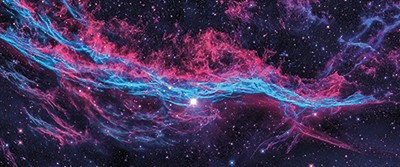Bright Stars in Galaxies Far, Far Away

By Nancy H. Pitts
Surely you’ve looked up at the clear night sky and, many nights, thought to yourself, “The stars are especially bright tonight.” Scientists are thinking about the stars, too. For decades they have also been interested in the nebula a star leaves behind when it “goes out,” or dies.
A planetary nebula is a hazy cloud that surrounds a dying star after it sheds its protective outer layer of gas. Unprotected, the “stellar core” of the dead star heats up fast and pumps radiation into the gas layer it is shedding, creating a beautiful, brightly colored nebula, or shimmery three-dimensional halo, around itself. Its color is dependent on the type of gas that is set aglow. It can be so bright that it can be seen from Earth, such as the nebula in the constellation Orion about 1,400 light years away.
Scientists wonder why they are seeing nebulae where they are least expected. Some nebulae in galaxies that are 7 billion years old are as bright as those in galaxies that have only been around for a billion years. Previously, it was thought that the mass of a star dictated what sort of nebula it produced, implying that the nebula from a low mass star would not be bright enough to be seen from one galaxy to another. However, there are nebulae in ancient galaxies where no high-mass stars exist.
A New Theory
In May 2018, astrophysicist Albert Zijlstra and his colleagues at University of Manchester in the U.K. released results of simulations that show that even small stars can heat up enough to form very bright, very colorful planetary nebula. Zijlstra now theorizes that smaller stars can produce nebulae as bright as stars three times their size. This could help explain why bright nebulae are seen in ancient galaxies as well as in youthful galaxies.
We know that 90% of stars end up as planetary nebulae. Their indescribable beauty invites lively and imaginative thoughts about nebula and their ancestors, the stars. Are those dead stars really just degenerate white dwarfs, as they are sometimes referred to, or are they displaying a glorious, valuable, secret staying power that shines across galaxies for a reason we have yet to understand?
Discussion Questions
- Calculate the mileage to the Orion nebula named Messier 42.
- Do stars ever disappear completely? Research the evolution of a star.
Vocabulary
- Galaxy
- Constellation
- Nebular
- Simulation
- Stellar